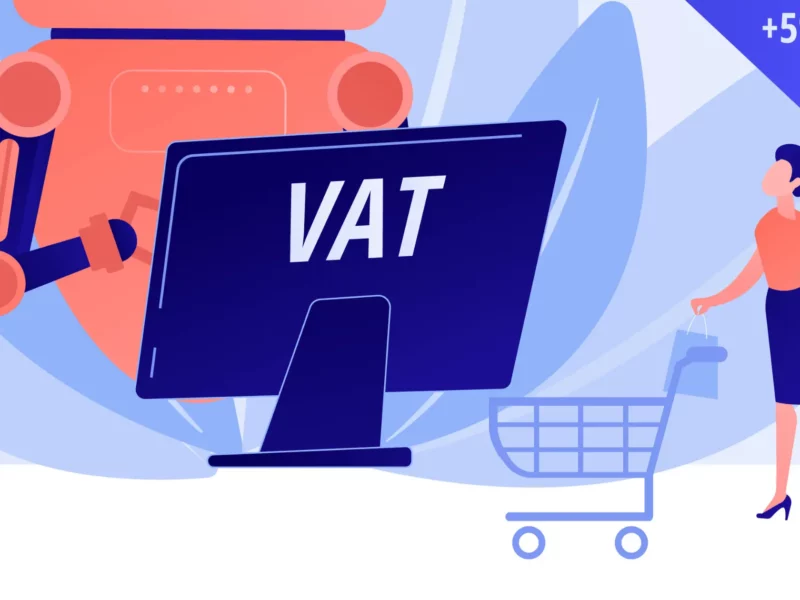Table of Contents
Introduction to VAT Bridging Loans
VAT Bridging Loans plays an integral role in the realm of financing as they have gained significant popularity. These loans act as a reliable financial tool for individuals and businesses dealing with Value Added Tax (VAT) implications in property transactions. To gain a comprehensive understanding of how these loans work and their benefits, let’s delve into the intricacies of VAT bridging loans.
What is a VAT bridging loan?
A VAT bridging loan is a short-term financing solution designed to bridge the gap between the time VAT payments are due and the actual reimbursement from HM Revenue & Customs (HMRC). This type of loan allows individuals and businesses to access the funds they need to fulfil their VAT obligations promptly without affecting their cash flow.
How does a VAT bridging loan work?
When a VAT-registered business or individual undertakes a property transaction, they are required to pay VAT promptly. However, the reimbursement from HMRC often takes a considerable amount of time. This is where VAT bridging loans come into play. These loans provide the necessary funding to cover VAT payments, ensuring a smooth and timely transaction, while borrowers await their VAT refund.
Why are VAT bridging loans useful?
VAT-bridging loans offer several advantages that make them a valuable financial tool in the realm of property transactions. The primary benefit of these loans is their ability to alleviate significant cash flow limitations. By securing a VAT bridging loan, borrowers can satisfy their VAT obligations without affecting their working capital, which is particularly beneficial for businesses involved in property acquisitions.
Understanding Value Added Tax (VAT)
Value Added Tax (VAT) is an indirect tax levied on the consumption of goods and services within the United Kingdom and European Union. It is a crucial revenue source for the government and plays a significant role in the functioning of the economy.
Definition and purpose of VAT
VAT is levied at each stage of the production and distribution process, with businesses responsible for collecting and remitting this tax to the government. The purpose of VAT is to generate revenue for the government while ensuring that the burden of taxation is distributed throughout the supply chain, ultimately being borne by the final consumer.
VAT registration and obligations
Businesses with a taxable turnover exceeding the VAT registration threshold are required to register for VAT. Once registered, these businesses have certain obligations, including charging VAT on their supplies, submitting regular VAT returns, and paying any VAT due to HMRC. Failure to comply with these obligations may result in penalties and legal consequences.
VAT and Property Transactions
VAT plays a crucial role in property acquisitions, and understanding its implications is essential for property developers and investors.
VAT implications in property acquisitions
When acquiring a property, VAT considerations are vital for both commercial and residential transactions. In commercial property transactions, VAT is typically chargeable on the sale price, and the buyer can usually reclaim this VAT, subject to certain conditions. For residential property transactions, VAT is generally exempt. However, there may be exceptions, such as newly constructed properties or those being sold as part of a business.
VAT considerations for property developers and investors
Property developers and investors must carefully evaluate the VAT implications of their projects. They need to consider the intended usage of the property, any applicable exemptions or reduced rates, and the potential VAT implications during the construction phase.
Challenges in VAT Payments for Property Transactions
VAT payments can pose challenges for businesses involved in property transactions, especially considering the timing and cash flow limitations.
Cash flow limitations in VAT payments
Prompt payment of VAT is crucial to comply with legal obligations. However, the immediate payment of significant sums can strain businesses’ cash flow, affecting their daily operations and commercial viability. This is particularly true for SMEs or businesses with limited access to working capital.
Delayed VAT refunds and timing issues
While businesses are entitled to VAT refunds, the reimbursement process from HMRC can often be time-consuming. Delays in receiving these refunds can hinder a business’s financial stability, impeding their ability to invest in growth opportunities or fulfill other financial obligations.
You can also see what Bridging Loans in the UK looks like.
Bridging Loans Explained
To fully grasp the concept of VAT bridging loans, it’s essential to understand the basics of bridging loans themselves.
Basic overview of bridging loans
Bridging loans are short-term loans that help bridge the gap between the purchase of a new property and the sale of an existing property. These loans provide immediate access to funds to facilitate smooth property transactions while borrowers await the receipt of funds from property sales or other financial sources.
How bridging loans differ from traditional loans
Unlike traditional loans, which are typically long-term and require extensive documentation and credit checks, bridging loans offer a more streamlined and accessible financing alternative. These loans are primarily asset-based, with the property being acquired or sold serving as collateral, allowing borrowers to secure funds quickly.
VAT Bridging Loans: A Solution for Property Transactions
VAT bridging loans play a significant role in facilitating property transactions, particularly when VAT payments are involved.
Role of VAT bridging loans in property transactions
VAT bridging loans act as a financial lifeline for businesses and individuals involved in property transactions, providing the necessary funds to meet VAT obligations promptly. By securing a VAT bridging loan, borrowers can maintain their financial stability and achieve a seamless property acquisition experience.
Benefits of using VAT bridging loans
The benefits of utilizing VAT bridging loans are manifold. Firstly, these loans eliminate the burden of immediate VAT payments, ensuring that businesses can allocate their existing capital to other operational needs. Additionally, VAT bridging loans can soften the impact of delayed VAT refunds, enabling businesses to continue their operations without being hindered by potentially lengthy reimbursement processes.
Eligibility and Criteria for VAT Bridging Loans
While VAT bridging loans offer exceptional benefits, certain eligibility criteria must be met to secure these loans successfully.
Qualification requirements for VAT bridging loans
To be eligible for a VAT bridging loan, borrowers should be VAT-registered businesses or individuals involved in property transactions subject to VAT. The lenders typically evaluate the borrower’s creditworthiness, the risk associated with the property transaction, and the feasibility of the loan repayment.
Loan amounts and interest rates
The loan amount available for VAT bridging loans may vary depending on the borrower’s circumstances and the lender’s assessment. Interest rates are determined based on various factors, including the loan-to-value ratio, the borrower’s creditworthiness, and prevailing market conditions.
Application and Approval Process
Applying for a VAT bridging loan involves providing specific documentation and undergoing a streamlined approval process.
Necessary documentation for VAT bridging loan applications
When applying for a VAT bridging loan, borrowers are required to provide documentation such as proof of VAT registration, details of the property transaction, identification documents, and financial statements. These documents enable lenders to assess the feasibility of the loan request and make an informed lending decision.
Loan approval timeline and process
The approval timeline for VAT bridging loans may vary depending on the lender’s internal processes and the complexity of the loan application. However, with the streamlined nature of these loans, borrowers can often expect relatively quick loan approvals, allowing them to proceed with their property transactions without unnecessary delays.
Repayment Terms and Options
Understanding the repayment terms and options associated with VAT bridging loans is crucial to plan for a successful loan repayment.
Repayment schedules for VAT bridging loans
VAT bridging loans usually have a short-term repayment period, ranging from a few months to a year. The agreed-upon repayment schedule can vary depending on the borrower’s preferences and the lender’s terms. Repayment may be either at the end of the loan term or through partial payments throughout the loan period.
Potential penalties and late payment considerations
Late payments or failure to honor the agreed-upon repayment schedule may result in penalties and additional fees. It is vital for borrowers to carefully evaluate their financial capabilities and ensure timely payments to avoid any unfavorable consequences.
VAT Bridging Loan Providers and Options
Numerous lenders specialize in providing VAT bridging loans, offering borrowers a range of options to choose from.
Leading VAT bridging loan providers in the market
While several lenders offer VAT bridging loans, some established names in the industry have gained recognition for their expertise and reliability. Conducting research and seeking recommendations can help borrowers find lenders who are reputable and offer competitive terms.
Comparing different VAT bridging loan options
Borrowers should consider various factors such as interest rates, loan-to-value ratios, repayment terms, and customer service when comparing different VAT bridging loan options. This thorough evaluation ensures borrowers choose the most suitable lender to meet their specific needs and goals.
Key Considerations before Applying
Before applying for a VAT bridging loan, borrowers should thoroughly evaluate the viability of this financing option.
Evaluating the viability of VAT bridging loans
Borrowers should carefully assess their financial situation, the potential benefits of VAT bridging loans for their specific property transaction, and their ability to meet the repayment obligations. It is essential to have a detailed understanding of the challenges and benefits associated with these loans to make an informed decision.
Analyzing risks and potential drawbacks
While VAT bridging loans offer significant advantages, borrowers must also be aware of potential risks and drawbacks. It is crucial to consider factors such as interest rates, penalties for late payments, and the impact on cash flow to determine whether a VAT bridging loan is the right choice for their circumstances.
VAT Bridging Loans vs. Other Financing Options
Comparing VAT bridging loans with traditional bank loans and exploring alternative financing avenues is essential for borrowers seeking the most suitable option.
Comparing VAT bridging loans with traditional bank loans
VAT bridging loans differ from traditional bank loans in various aspects. Traditional loans often involve lengthy approval processes and require extensive documentation, making them less suitable for urgent financial needs. VAT bridging loans, on the other hand, provide a streamlined and efficient alternative, prioritizing speed and accessibility.
Exploring alternative financing avenues
VAT bridging loans may not be the ideal solution for every situation. Exploring alternative financing avenues, such as angel investors, crowdfunding, or peer-to-peer lending, can offer borrowers a more comprehensive understanding of the options available to them.
Tips and Strategies for a Smooth VAT Bridging Loan Experience
Managing the VAT bridging loan process can be made smoother with the following tips and best practices.
Best practices for managing VAT bridging loan processes
To ensure a smooth VAT bridging loan experience, borrowers should maintain organized financial records, communicate effectively with lenders, and stay informed about any changes in legislation or regulations. Having a clear repayment plan in place and promptly responding to any lender queries can significantly streamline the loan process.
Minimizing potential challenges
Challenges may arise during the VAT bridging loan process, but by adopting proactive measures such as conducting thorough due diligence, seeking expert advice, and planning for contingencies, borrowers can minimize potential hurdles and ensure a successful loan experience.
Legal and Regulatory Considerations
Understanding the legal and regulatory aspects of VAT bridging loans is imperative to ensure compliance and avoid any consequential issues.
Legislative frameworks relevant to VAT bridging loans
VAT bridging loans operate within the legal framework set forth by local legislation. Borrowers should familiarize themselves with the specific laws and regulations governing VAT bridging loans in their jurisdiction to ensure compliance.
Compliance obligations for borrowers and lenders
Both borrowers and lenders have compliance obligations when it comes to VAT bridging loans. Borrowers must adhere to the terms and conditions of the loan agreement, including timely repayments. Lenders, on the other hand, must operate within legal parameters and fulfill their responsibilities related to loan documentation and advice.
Understanding the Risks associated with VAT Bridging Loans
As with any financial instrument, VAT bridging loans come with inherent risks that borrowers must identify and manage.
Identifying and managing potential risks
Borrowers should carefully assess the risks associated with VAT bridging loans, such as fluctuating interest rates, challenges in obtaining a VAT refund, or unexpected changes in property market conditions. By proactively identifying these risks, borrowers can implement suitable risk management strategies.
Creating contingency plans
Having contingency plans in place is essential to address unforeseen circumstances or potential challenges throughout the VAT bridging loan journey. These plans should include strategies for managing delays in property transactions, dealing with unexpected costs, or adapting to market disruptions.
Summary and Conclusion
VAT bridging loans offer a valuable solution for businesses and individuals involved in property transactions, enabling them to meet their VAT obligations promptly and maintain a steady cash flow. Understanding the fundamentals of VAT bridging loans, evaluating their benefits and risks, and exploring the available financing options is crucial for borrowers seeking a smooth and successful loan experience. By harnessing the power of VAT bridging loans and incorporating best practices, borrowers can unlock opportunities and navigate property transactions with confidence.
In conclusion, VAT bridging loans provide a strategic tool for managing VAT payments in property transactions, ensuring financial stability and facilitating seamless acquisitions. By carefully considering the outlined factors, borrowers can make informed decisions, optimize their loan experience, and ultimately pave the path towards property transaction success.






